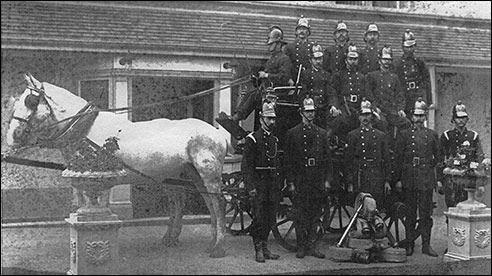|
The first documented fire appliance based at Burton Latimer was a horse-drawn manual appliance built by Shand, Mason and Co. of London. This was delivered to Burton Latimer Parish Council in May 1914, and is believed to have replaced a previous Shand Mason horse-drawn appliance which was in use at least from 1901, when the new fire station was opened in Duke Street. This appliance was inspected during 1903 by Earls Barton fire brigade who where looking at buying a similar appliance.
The Kettering Leader newspaper dated 23 January 1914 reported that Burton Latimer Parish Council was considering the offer of a loan of a fire appliance from Kettering Urban District Council at the cost of £5 per year. This proposal is believed to have been an agreement that the Council were considering at the time with Kettering Urban Council whereby Kettering's steamer appliance would be made available to attend any large outbreaks of fire in the Burton Latimer area as backup to the Burton Latimer manual pump, the cost of which would be £5 per year, Rothwell Council were also considering the same idea after they had suffered a large fire just previous to this period.
The new appliance was a 16-man machine, this meaning it needed 16 men to operate it, and eight men each side to pump the handles up and down to pump the water through the hose. Usually this would be the job of any bystanders at the scene, who would then receive payment from the fire station after the fire. With this appliance, if pumped at 55 double strokes (one up and one down) per minute, it was capable (when new) of pumping 62.3 gallons of water per minute, compared to today's usual 500 gallons per minute. This appliance also carried a short ladder for rescues, etc. The main drawback with this type of appliance was that in order to get it to work, it had to be set into a water supply before the hoses could be got to work. The other main drawback was that it needed horses to pull it, and these had to be fetched from their field which was quite a distance from the station. This must have caused severe delays in turning out.
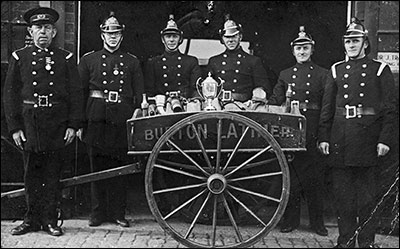 |
|
Members of the Burtom Latimer Fire Brigade 1930s
|
|
At the same time as the manual pump was in use, it is believed that a hose cart was also in use. In other areas the hose cart would be the first 'appliance' to be taken to a fire, and would have been pulled by hand. The hose cart is believed to have contained a standpipe for connecting into the street water mains, as well as hose and a branch. The idea of the hose cart was to enable the firemen to start fire fighting prior to the arrival of the main pumping appliance. There are again no records to confirm that the hose cart was used in this way at Burton Latimer, but it is known that the hose cart at Kettering was used as described above. The hose cart at Burton Latimer was used in later years for competition drills between stations, for which a cup was presented to the winning station each year; this cup is now on display at Burton Latimer station. |
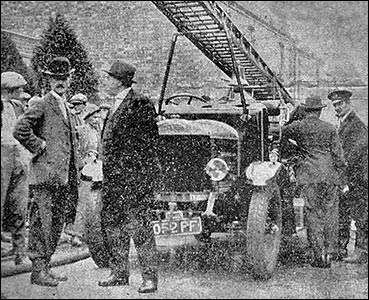 |
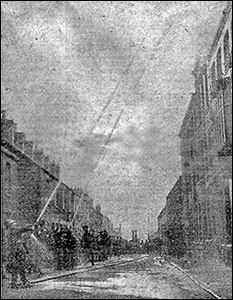 |
|
Cllr. Frank Barlow, left, with other councillors
at the engine demonstration in 1927
|
Demonstration in Finedon St
at Whitney & Westley's factory
|
The next appliance was purchased after having two other motorised appliances come to Burton Latimer to give a demonstration to the Council in 1927. It is believed from these appliances came from Kettering, as the person in charge of the demonstrations was Captain Brewster from Kettering fire brigade. These demonstrations involved one display of pumping from the water mains at Whitney and Westley’s factory in Finedon Street, and then one demonstration of pumping from open water at Messrs. Wallis flour mill (now part of Weetabix). The appliance that was chosen was a Dennis 25hp motorised appliance, which was delivered in May 1928, this was an open top vehicle, with spoked wheels and solid tyres. This was a great improvement over the horse-drawn pump in that the engine replaced the horses, and also powered the pump as well.This vehicle was fitted with an "Ajax" double extension ladder. Later on in years the wheels and tyres were changed to solid rims and pneumatic tyres.
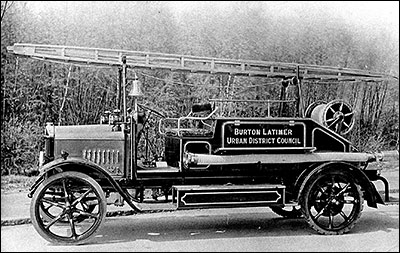 |
|
Burton Latimer Urban District Council's Dennis 25hp fire engine purchased in 1928
|
|
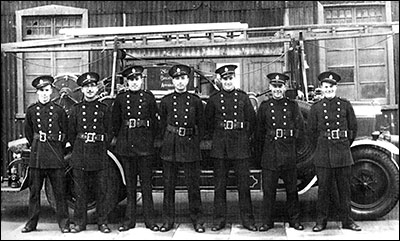 |
Burton Latimer Fire Brigade 1942
L- R: Pete Barlow, Frank Clipston, Gilbert Neville, Jack Oram, Bill Griffith, Fred Toseland and Ron Coleman. The Dennis fire engine now has pneumatic tyres
|
|
This appliance was replaced in May 1949 and sold to a scrap dealer at Finedon, along with similar pumps from Wellingborough, Irthlingborough, and Desborough. The total price paid for the four scrap vehicles being just £84.
The next appliance to arrive in May 1949 was an Austin A40 and trailer pump (reg. no. GXH 301). This again was fitted with an "Ajax" ladder, and was fitted with a water tank in the rear, as well as all the other fire-fighting equipment carried at the time. This appliance was again an improvement over the Dennis pump, as it was fully enclosed, so the crew had protection from the elements while dressing in the rear, and for the driver and officer in charge in the cab. Although there was room in the rear for the crew, the sides of the appliance were fitted with only one very small window in each side, so the crew could not see out very easily. This appliance was also fitted with a side-mounted pump, which was built into the near side of the appliance, just behind the cab.
The next appliance to come to Burton Latimer in the late 50's/ early 60's was a Bedford appliance (reg. no. RNV196). This appliance remained in use up to 1974 and was transferred to the new station in Pigotts Lane for a short while before being replaced. This appliance had only one set of doors each side of the crew cab, with the officer in charge and driver having to ‘climb over’ to get to the front of the cab.
The next appliance was another Bedford (reg. no. LRP 554E). This appliance was on the run from 1974 until approx. 1980. This appliance was of the standard design for a water tender at the time. This included a 500 g.p.m pump, a 10.5m. double extension ladder, short extension ladder (5m.), roof ladder, various hose and other equipment as well as four lengths of 4" suction hose for getting water from an open supply. A portable pump was also carried; this was capable of pumping 250gpm.
This appliance was replaced by a Dennis appliance (reg. no. TVV 356K), which was transferred from the Mounts station at Northampton. This appliance was classed as a major pump by the NF+RS as it was capable of pumping 1000 gpm through four deliveries (standard pumps only had two deliveries & delivered 500 gpm); its suction hose was 5" diameter, compared to the normal 4" diameter. This was in order to give the extra lift when working from open water. Apart from this, the appliance was the same as the standard pumps except for the body colouring. The standard appliances usually had red cab and silver bodies, but the Dennis was red all over. Also the standard pumps were fitted with roller shutter doors on the lockers, whereas the Dennis doors were hinged at the top, and had to be lifted by hand. With reference to the body colours, at one time the Dennis appliances had been painted fluorescent yellow for use on the Ml motorway, but had since been re-sprayed red.
The engine in the Dennis was a Rolls Royce 8 cylinder petrol engine, giving plenty of power, but using lots of fuel (approx. 4mpg). The Dennis was removed from service approx. 1985/86 following major engine failure.
The next appliance to arrive was another standard Bedford appliance (reg. no. ONH 769V). This appliance remained at Burton Latimer until approx. 1990/91.
The next appliance to arrive was a Dodge appliance (reg. no. F 110 CBD). This appliance was of the standard design but had been updated with a 13.5m. ladder. This appliance was at Burton Latimer until approx. 2000-2001.
The present appliance is a Dennis (Reg. No. L I03 JRP) - again this is a standard design appliance. This appliance is due to be changed within the next one to two years.
In recent years the fire service has updated most equipment, the main improvements being RTA equipment and also chemical protection equipment. This is due to the fact that the fire service now deals with as many, if not more, road traffic accidents and vehicle fires as we do property fires.
The area covered by Burton Latimer fire station covers all of Burton Latimer, Isham and Cranford, in the event of a fire engine being needed in any of these areas; Burton Latimer station would be the station that is mobilised. The station is also the second fire engine to other nearby areas, these include almost all of Barton Seagrave and all of Finedon. This means that in the event of a call to these places if more than one appliance is required, Burton Latimer would be sent as the Second Appliance.
Although it appears from this that Burton Latimer only gives cover in the local area, this is misleading as we can be called upon to go anywhere in the county if required, or even possibly out of the county.
During 2005, Burton Latimer attended 178 calls, ranging from stolen cars being set alight and house fires to cutting people from crashed vehicles on the A14.
|
